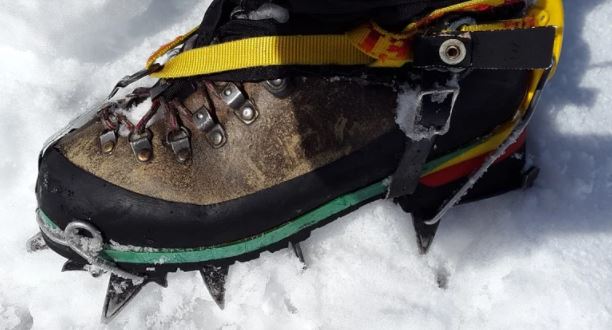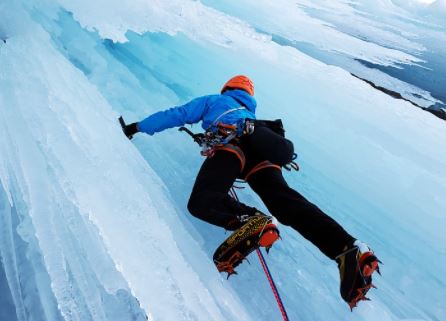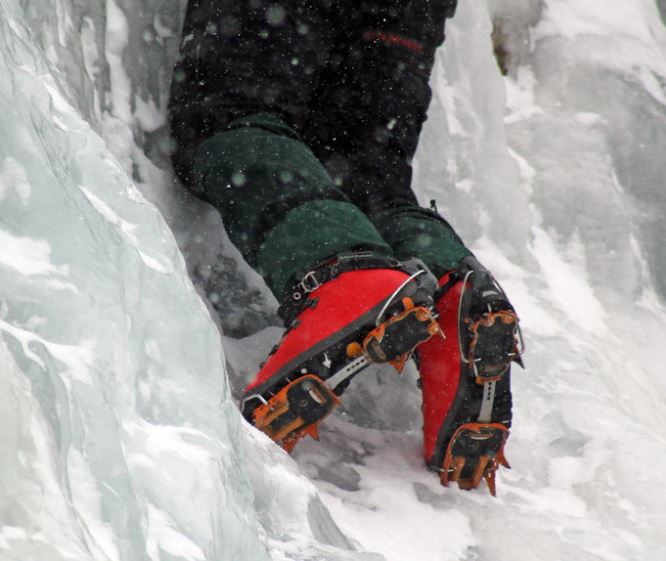If you are into ice climbing, then you know just how essential a good pair of crampons can be. But what are crampons, exactly?
Crampons are a type of footwear that is specifically designed for ice climbing. They are frames with metal spikes on the bottom that you strap to your boots to help provide traction on ice, making it easier and safer to climb.
But what makes them so important for this type of climbing?
In this article, we will answer these questions and more.
We’ll provide an overview of what crampons are and explain why they are such an important piece of gear for ice climbers, backpackers, and mountaineering.
So if you’re curious about this essential piece of equipment, read on!
What Are Crampons?

As we mentioned, crampons are a type of footwear that is designed for ice climbing.
They have large metal spikes on the bottom that help to dig into the ice, providing a safer climb with plenty of traction.
Crampons come in a variety of shapes and sizes, but they all serve the same purpose: to help you grip the ice and move up the climb.
Crampons were introduced by Oscar Eckenstein in 1908 as an alternative to nailed boots for ice climbing and mountaineering, and were eventually mass marketed by an Italian blacksmith named Henry Grivel, and the two together changed the game for ice climbers and mountaineers.
Grivel is one of today’s leading mountaineering gear brands thanks to this initial partnership.
What Are Crampons Used For?
Crampons are used for a variety of activities, but they are most commonly associated with ice climbing.
As we mentioned, crampons help you to “dig in” to icy surfaces, providing grip where you would normally not even have a chance of traversing the slippery terrain, opening up new areas in nature for exploration.
They can also be used for hiking on snow and ice, as well as mountaineering.
In fact, crampons were first introduced for use in mountaineering, before eventually becoming popular among ice climbers.
No matter what activity you are using them for, crampons are an essential piece of equipment if you want to safely navigate icy terrain.
Related: how to choose between crampons vs microspikes.
Why Are Crampons Important?
Crampons are essential for ice climbing because they provide traction on the ice, making it easier and safer to climb.
Without them, you would risk injury or death, or have to turn back to avoid icy areas.
If you have crampons, you can lock them onto your boots and keep going while also making sure you are safe, making them an invaluable piece of gear for anyone who encounters ice during their adventures.
Types Of Crampons

There are a few different types of crampons available on the market, each with their own set of features and benefits.
There are two main types of crampons: frame and hybrid.
Frame Crampons
Frame crampons have a metal frame that goes around the boot, with spikes sticking out of the front, back, and sides.
Front crampons are best for doing a lot of front-pointing (a type of ice climbing where you kick the front points of your crampons into the ice to climb).
Hybrid Crampons
Hybrid crampons, on the other hand, have a metal frame in the front with spikes sticking out of the sides, and a plastic or rubber back.
If you are looking for a lighter weight option, or one that is easier to walk in, then hybrid crampons might be a better choice.
What Are Hiking Crampons?
Hiking crampons are a type of hybrid crampon that is designed for use on hiking trails, rather than mountaineering or ice climbing.
They have a metal frame in the front with spikes sticking out of the sides, and a plastic or rubber back.
Hiking crampons are a great choice for anyone who wants the benefits of a hybrid crampon without the weight or bulk.
They ultimately serve the same purpose as crampons but are better for situations where you’ll be transitioning between different terrain types often during a trek.
What Are Ski Crampons?
Ski crampons are a type of crampon that is designed for use with ski bindings that allow skiers to climb on icy surfaces or hard crust.
Different Parts Of A Crampon
Now that we’ve gone over the what a crampon is and different types of crampons, let’s take a closer look at what they are made of and how they work.
Crampons have two main sections that each contain their own individual parts: the base and the binding system.
Crampon Base Components
Teeth: The crampon teeth, also called points or spikes, are the metal pieces that dig into ice to provide grip and traction.
Frame: The frame is the part of the crampon that goes around your boot. It is typically made from aluminum or steel, and it can be either rigid or flexible.
Anti-Bailing Plates: These plates keep snow from sticking in your crampons, and are usually placed at the toes and heels.
Flex Bar: The flex bar links the front and rear crampon plates together, and there are different flex ratings that allow varying levels of stiffness.
Binding System Components
Toe Cage: Encloses the toes.
Heel Clip / Heel Lever: Wraps around the heel of your boot to secure the crampons.
Binding Straps: These straps are used to secure the crampons. Some feature buckles, straps, or levers.
Crampon Ratings & Compatibility Explained
We often hear people new to ice climbing and mountaineering ask: “what are C1 and C2 crampons?”.
It all has to do with crampon-compatible boots.
Hiking boots and mountaineering boots that are compatible with crampons are rated B1, B2, or B3, with the higher number indicating a higher stiffness.
Crampons are rated similarly, so you’ll see them classified as C1, C2, or C3 crampons.
Generally you should match the numbers up, although you can use a lower-rated crampon with a higher rated boot, but not the other way around.
So for example, you can use a C2 crampon with a B3 boot, but you should never use a C2 crampon with a B1 boot.
- B1 boots and C1 crampons are best for glacier walking.
- B2 boots and C2 crampons are better for winter mountaineering.
- B3 boots and C3 crampons are best for ice climbing.
What To Look For When Buying Crampons

So, what are some of the things you should keep in mind when choosing a pair of crampons?
First, you need to think about what kind of ice climbing you will be doing.
Are you going to be climbing steep, icy routes, or will you mostly be scrambling over less-steep terrain?
You also need to think about what kind of boot you will be using.
Not all boots are compatible with all types of crampons, so it is important to make sure that the pair you choose is compatible with your boots.
Finally, keep in mind what kind of climate you will be using your crampons in.
If you are ice climbing in an area where there is a lot of ice, like Alaska, then you will want to choose a pair of crampons that have more aggressive spikes, to help you stay on the ice.
On the other hand, if you are mostly doing scrambling in dry conditions, like in the Rockies, then you can get away with a less aggressive pair of crampons.
No matter what type of climbing you are planning on doing, make sure to do your research and choose a pair of crampons that is right for you and your adventure!
How To Use Crampons
Using crampons is not difficult, but there are a few things you should keep in mind.
First, make sure that your crampons are the right size and compatible with your boots.
If they are too big or too small, they will not work properly and could be dangerous.
Second, when putting on your crampons, make sure that all of the straps and buckles are tight and secure.
You don’t want your crampons coming off in the middle of a climb!
Be sure you are familiar with the strap and binding system, as this is not something you want to figure out for the first time out in the field where your safety depends on it.
Always practice using your crampons before you head out on a climb.
How To Walk In Crampons: Proper Crampon Technique
Walking in crampons takes a little getting used to, as you’ll be a bit taller and the crampon points may throw off your gait.
Here are a few tips to follow when using crampons:
- Walk with your feet a little further apart than usual to avoid snags on clothing.
- Keep your feet flat to the ground with each step to ensure all your spikes provide traction.
- Turn your toes outward or turn your body sideways on steeper ground.
- If front-pointing, face into the slope and keep your heel level with your toes, taking small steps upwards, lowering your heel a little bit to help the points directly behind the front points to engage and increase grip.
What Are Crampons? Wrapping Things Up
So, we covered that crampons are a type of traction device that is worn on the feet, and they are used to help prevent slipping on ice or snow.
They’ve got a series of metal spikes that dig into the ice or snow, providing grip and traction, and there are different types of crampons for different activities, so be sure to choose the right pair for your needs.
Now that you know what crampons are and how to use them, you can head out into the mountains with confidence! Just remember to practice using them before heading out onto any technical terrain.
Stay safe and have fun!
Check out our other helpful guides while you’re here:
- How should hiking boots fit?
- Hiking Precipice Trail in Acadia National Park
- Hiking after ACL surgery
- Our guide to barefoot hiking
- How to measure your average hiking speed
- The best hiking boots for flat feet
- How long do hiking boots last?
- How to find out what size laces for hiking boots you need
- How to dry out hiking boots
- The best way to carry water while hiking
- How to stretch out hiking boots
- How to break in hiking boots

